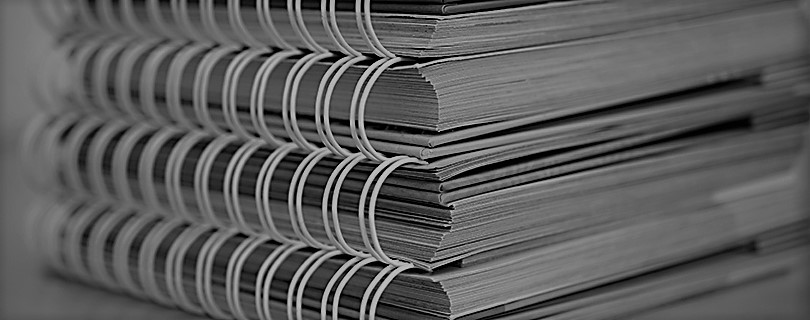Document Binding Options:
Corner Stapling: A form of binding where pages are laid on top of one another and stapled, normally in the top left corner.
Saddle Stitching / Booklet Making: A form of binding where pages are laid on top of one another, double stapled in the centre, and folded in half to form a booklet. Commonly used for magazines, Financial Reports and Brochures.
Strip Binding / Velo Binding / Sure Binding: Strip binding offers a professional look without staples, glue, or chemicals. Plus it is easy to achieve consistently, attractive and polished results. In a quick, two-step process, punched documents are secured between two thin plastic strips. The finished products are easy to stack, mail and file. Moreover the process works for reports, proposals and even library-quality hardcover books.
Coil Binding / Spiral Binding: Smooth, flexible, plastic coil binding is perfect for documents that need to lie flat or flip over. The continuous plastic binding element spirals through the punched holes, reducing the possibility of tearing and allowing the pages of your document to rotate 360 degrees.
Comb Binding / GBC Binding: Strong, durable, and economical-these are the reasons so many people choose plastic comb binding.
Wire Binding: Ring wire binding provide a contemporary, high-tech look. Documents open flat, in single sheets or spreads, and their pages can rotate 360 degrees. Wire binding is also especially durable and able to withstand temperature extremes. Wire binding systems are appropriate for all types of businesses and offer many ways to customize your documents appearance.
Tape Binding: Tape binding works by wrapping a narrow fabric strip around the spine of the covered document and securing the pages together using adhesive. Finished documents look great and are reader-friendly because they lie flat and are easy to store, stack, and mail.
Perfect Binding: Perfect binding is a form of adhesive binding. This binding is sometimes called “soft cover”, which is similar to a paperback novel binding. It is excellent for books, corporate reports, manuals, brochures, and annual reports. The advantages are: versatile, printable spine, longevity, overall look and visual appeal.
Document Finishing Services
Collating: The assembly of documents or sheets in reading sequence for binding.
Cutting / Trimming: The process of sizing the paper, either before or after it is printed / copied.
Hole Punching: Holes are drilled or punched into sheets so they can be used in notebooks and binders. The number, size and location of the holes can be adjusted to meet the requirements of the work.
Foam Board Mounting: Foam Core is a double sided coated mounting medium with a lightweight foam interior, providing a rigid light weight mount. Foam Board Mounting is a favourite for framed art and photos and is often used for in-store decor and exhibits.
Laminating: Important document(s) can be preserved by placing protective transparent layers over them. This will ensure that your document is preserved for a very long time. Available in different thickness, finishes and 1 or 2 sided.
Encapsulating: Two sided laminating with a heat sealed edge. Available in different thickness and finishes. Suitability: completely encapsulates the document(s) for protection.
Folding: Folding is a process in which the printed page is reduced in size by a series of folds that arrange the material in the organized fashion intended. In some cases, it is necessary to fold the printed sheet prior to additional finishing steps being performed.
Padding: Often used for forms, and for note and memo pads. Printed sheets are collated and stacked alternately with chipboard. The stacks are then clamped together and glue is applied to one side of the stack. After the adhesive is dry, the stacks are trimmed, if necessary, and separated into pads.
Perforation: Series of finely punched holes, that ensure a smooth crisp tearing of the sheet in a pre-described line.
Scoring and Slitting: Shallow indentation on the surface of a sheet of paper, ensuring a smooth, crisp fold. It is especially helpful for heavier stock that is folded against the paper’s grain.
Guillotining: A process when a machine with a vertical blade cuts or trims paper.


